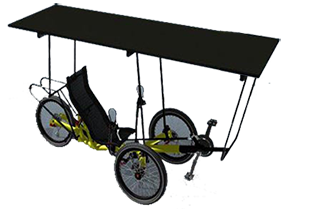Sun Tour America
Touring the Americas by human and solar power.

Memo
|
Executive summary
• The Problem: Too many people fail to meet minimum activity needs for optimal health and longevity, and transportation needs are met by unnecessarily minimizing human-power input to turning a wheel and pushing accelerator and brake pedals (when not sitting in a passenger seat).
• Program Goal: To develop and promote use of solar-based assisted e-cycle technology.
• Target Audiences: (1) All less than very fit humans (< 150W output) who will benefit by increasing their activity level. (2) E-cycle advocates. (3) Bicycle-based cargo carriers.
• Audience Objectives: The target audience will come to understand the need to meet minimum appropriate activity level and consider cycling (in addition to walking) with e-assist as needed.
• Major Strategy: Use Sun Tours to gain public attention and interest to promote healthy transportation choices that maximize benefits for society, individuals, and their environment.
• Recommended Budget: While some money is needed for web access and more would have its uses, human resources are primary. As an open source technology project, volunteer time and talent will make or break Sun Tour America's endeavor to promote adoption of solar e-cycle technology.
• Evaluation Plans: Success will be in proportion to the number of Sun Tours organized each year and the number of participants. Secondarily, website traffic will indicate public awareness of and interest in Sun Tours, as will media coverage.
Sun Tour America Mission Statement
 Sun Tour America (formerly Sun Trip America) aims to organize Sun Tours based on human-power (indirect solar) and photovoltaic power to explore the Western hemisphere, thereby promoting activity tolerance and solar e-cycle 'green' technology. Sun Tours are not races. Pace will be equivalent to what a very fit but sub-athletic person pedaling using human-only power could achieve: about 50 miles per day average. Sun Tours can be inclusive of those who lack athletic abilities, including the elderly who may be former athletes, by supplementing their human-power with e-motor assist technology. Pedaling enough to at least spin the pedals will be the norm (pedelec design), while those who have to motor without pedaling, using a throttle only, will be given a handicap permit to display.
Sun Tour America (formerly Sun Trip America) aims to organize Sun Tours based on human-power (indirect solar) and photovoltaic power to explore the Western hemisphere, thereby promoting activity tolerance and solar e-cycle 'green' technology. Sun Tours are not races. Pace will be equivalent to what a very fit but sub-athletic person pedaling using human-only power could achieve: about 50 miles per day average. Sun Tours can be inclusive of those who lack athletic abilities, including the elderly who may be former athletes, by supplementing their human-power with e-motor assist technology. Pedaling enough to at least spin the pedals will be the norm (pedelec design), while those who have to motor without pedaling, using a throttle only, will be given a handicap permit to display.
Key findings:
-
Unfit humans cannot output enough power to make bicycle technology practical.
-
Average fit humans cannot maintain enough output power to overcome moderate slopes and/or headwinds, and at times will require assist to avoid becoming overstressed.
-
Moderate e-motor assist can supplement human-power to make bicycle technology practical for the greatest number.
-
Modest electric pedal assist energy requirements can be met using solar power.
-
An activity level equivalent to walking for a total of two hours in 24 hours is minimal for maintaining health.
-
Cycling at walking power output levels with e-power assist meets activity requirement and provides needed mobility.
-
Onboard solar power eliminates the need to plug-in and makes solar touring possible.
Key findings are detailed in the following articles:
The Limits of Human Power: For average humans, why bicycle technology fails
What is an E-Bike?: Defining the nature of the beast—legally and otherwise
A Guide to Low-Power Cycle Tech: Why low-power is better than no power
Cycling Health and Safety: Benefits outweigh manageable risks
Cycling Power and Speed: The Power of Enough
On the Superiority of Human Power: When the hoof is mightier than the wheel